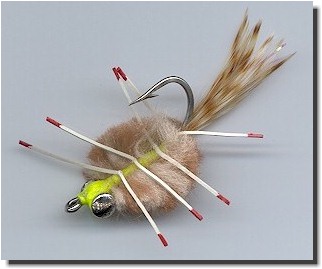
Del Brown (1918-2003) was known as the king of Permit fishing with over 500 Permit caught in his lifetime — a feat that will probably never be matched. It was a special fly, the Merkin crab, that Del developed and perfected that led to his success at catching one of the most elusive flats species. Crabs will migrate from one area to another by swimming near the surface using the tides and wind to propel them. This fly mimics a small or juvenile crab trying to escape by swimming to the bottom when predatory fish approaches. It is the crab swimming to the bottom that Permit key on. What makes this fly so special is the way it ‘swims’ to the bottom. A crab folds up its claws and non- swimming legs and swims sideways with its two swimming legs — the legs on the back of the crab. Because of the shape of a crab and the way the swimming legs move, a crab cannot swim straight down to avoid a predator — they swim to the bottom at an angle. The lead eyes, shape of the fly, and rubber band legs all combine to make this Merkin crab look like a small or juvenile crab as it swims at an angle to the bottom. Crabs, such as a juvenile blue crab (Callinectes sapidus), are a favorite food of many species besides Permit including Red Drum (redfish), Black Drum, speckled seatrout and Sheepshead. This pattern can be tied with different color yarn and rubber bands to mimic several different species of crabs. The pattern described below uses the traditional colors tied by Del Brown.
MATERIALS LIST:
Hook – Tiemco 811S size 4 or equivalent
Dumbbell eyes — medium silver or grey ( adjust size for sink rate)
Thread – Danville 3/0 thread or equivalent — fluorescent green
Tail – Krystal Flash and 2 brown hackle feathers
Body – Light brown, tan, or multi-colored yarn (the color of the yarn should vary depending on the species of crab but should be muted earth tones of brown, tan, gold, green or gray). Original material for the body is Aunt Lydia rug yarn 🧶 in tan and brown.
Legs – White round rubber band legs marked with Red marker
Tying the Merkin Crab
- Tie the thread in just behind the eye as a thread base for the lead eyes. Then tie the dumbbell eyes right behind the eye of the hook on the top of the hook. This will make the hook point ride up.
- Wrap the thread from the dumbbell eyes to just a little past the bend of the hook.
- Tie in 4-6 strands of Krystal Flash at the bend of the hook so they point up at about a 30-degree angle when the fly is riding hook point up. Then splay 2 brown hackles at the bend of the hook making sure they point out from each other and up at about a 30-degree angle like the Krystal Flash. These feathers mimic the claws of the crab. The feathers should be 11/2 times the length of the hook.
- Cut 5 lengths of yarn about 1 1/2 inches long. Tie in the yarn on the top of the hook using
X wraps, starting at the bend of the hook and finishing just behind the dumbbell eyes. The yarn should be evenly spaced and exactly perpendicular to the hook shank. If you are using multiple colors of yarn, vary the colors to give the fly a mottled look. - Trim the yarn to give the crab a teardrop shape with the narrowest part near the dumbbell eyes. (Many tiers cut the yarn to make the fly look like a circle. Del Brown’s original pattern was teardrop shaped so that it sank to the bottom at an angle.) Start by trimming the yarn just behind the dumbbell eyes. Then taper the yarn so that the closer to the hook bend, the longer the yarn. Then just past the middle of the fly round off the yarn to give the fly a teardrop shape. The widest part of the yarn should be about 7/8ths of an inch.
- Wrap the thread forward to the eye of the hook and whip finish the thread. Tie in 4 pieces of round white rubber legs. The legs should be evenly spaced between the dumbbell eyes and the bend of the hook — put one rubber band leg between each of the pieces of yarn. For each rubber band leg, use 2 overhand knots on the bottom of the hook shank (closest to the hook point). The first overhand knot should be an over-under knot and the second overhand knot should be an under-over knot. By alternating the over-under and under-over overhand knots, the rubber band legs will be exactly perpendicular to the hook shank. If you use a single overhand knot, the rubber band legs will come off the hook shank at an angle and not be perpendicular to the hook shank.
- Trim each rubber band leg so it is approximately twice the length of the yarn. With the red marker, color the last 1/8 inch of each of the legs.
Regards, Ken Prager